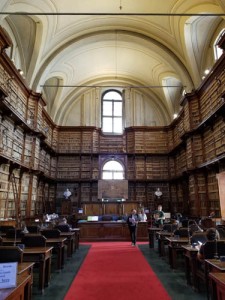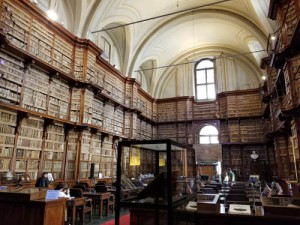From the time I learned to read, I have been a bibliophile—I’m a book lover. Books take me back in time, they encourage my dreams, they inspire me, they transform my life. Any library then houses greatness, but some places seem to really understand the greatness of their collection and their exterior represents the treasures of the bound tomes within their walls. Here are the five best libraries in the world according to this bibliophile (at this time, I plan on journeying much more):
New York Public Library
When built: cornerstone laid on November 10, 1902
Fun fact: After Pearl Harbor was attacked, the most valuable volumes and manuscripts at the Library were moved to bank vaults around New York City. 12,000 items from the collection, valued at that time at $10 million, were temporarily moved to a secret location 250 miles away.
Since I first saw Ghostbusters, I have been in love with the New York Public Library’s 5th Avenue location—the Stephen A. Schwarzman building. With majestic lions out front of its colonnaded portico, the entryway reminds visitors that reading is ritzy and elegant. The Beaux Arts exterior looks like a palace and the famous Rose Reading Room within reinforces that image. With 52-foot high ceilings, massive windows, and grand chandeliers, the room invites thoughtful contemplation and inspires genius. When it opened in 1911 the building was the largest marble building every built in the United States. The New York Public Library’s Main Branch has changing exhibits highlighting books, papers, letters, and other finds from their collection. The collection is huge with historic photographs, manuscripts, maps, sheet music, and videos accompanying the expected books. The NYPL features a rare book division, which is rich in Americana from the 17th and 18th centuries. They have printings from the 1400s, first folio editions of Shakespeare, important holdings from voyagers (James Cook, Lewis and Clark, Christopher Columbus), rare Bibles, the first book printed in North America, and other rarities. A visitor’s guide will help you as you wander around this bibliophile’s dream space.
Morgan Library
When built: 1906
Fun fact: Pierpont Morgan’s immense holdings ranged from Egyptian art to Renaissance paintings to Chinese porcelains. His collection was vast including not just printed books, but manuscripts (some illuminated), papyrus fragments, tablets, ancient seals, music, drawings, paintings, artifacts, and much more. At the Morgan one can travel across the world and through time!
John Pierpont Morgan sure knew how to read in style. The Morgan Library (built between 1902 and 1906) took me to another time (and class) when a vast library was an indication of a cultured person. The Morgan family were an influential financiers who accumulated a massive amount of wealth. By the late 1800s (Gilded Age), J.P. Morgan was one of the richest men in the world. His New York mansion epitomized Gilded Age excess. The library gives you insight into his home, whereas there are also exhibits in the much more modern exhibition space attached to Mr. Morgan’s Library, Study, and Rotunda. The galleries are filled with treasures, including traveling exhibits of quite some renown. Each room is lavishly decorated and speaks to a gilded age. The library features three floors of bookshelves with frescoed ceilings, fabulous tapestries, and a monumental fireplace. The rotunda leading into the library reinforces that one is entering a space of greatness. Mr. Morgan’s study features paintings by Renaissance masters and much more.
The collection includes drawings and prints (Peter Paul Rubens and more), medieval and Renaissance manuscripts, rare printed books, literary and historical manuscripts, music (like that by Wolfgang Amadeus Mozart), ancient Near Eastern seals and tablets, paintings, art objects, photography, and some of the most fantastic treasures money can buy (and the Morgan family could purchase a lot!). It was here that I was able to view the famed Crusader Bible—its pages rich with biblical stories gilded in gold and saturated with color even 800 years later. It is a fantastic example of French Gothic illumination. This library, Mr. Morgan’s study, the Rotunda, and the other exhibit spaces are well-worth the price of admission, but they often have free admission hours on Friday evenings.
Laurentian Library Florence
Fun facts about holdings: houses around 11,000 manuscripts, 2500 papyri, 43 ostraca, 566 incunabala, and thousands of prints from the 1500s-1900s. The library holds the Nahuatl Florentine Codex, which is the major source of pre-conquest Aztec culture. There are also 6th century Syriac Rabula Gospels and other important religious texts, as well as a fragment Erinna papyrus containing poems of a contemporary of Sappho.
When built: opened in 1571 (construction began in 1525)
All libraries are sacred places to me, but the Laurentian Library in Florence epitomizes that feeling. To enter, you walk behind the church of San Lorenzo along the courtyard of cloister. After walking up cloister stairs, Michelangelo’s architectural genius strikes you as you encounter the elaborate vestibule with a fantastic staircase that he designed and Ammannati built. The staircase leads you into a light, airy reading room with massive wooden desks which once held books inside them (no stacks needed). At the end of each desk is found a card that detailed the texts which would could be read at that location. One’s eyes are drawn all over from the stately windows to the red and white terracotta floors to the wooden coffered ceiling. The ceiling dates from the mid-1500s, as do the floor and windows making the library a unified work of the High Renaissance. This important and prestigious collection of antique books is part of the cultural heritage the Medici family bestowed to Florence…and the world. Cosimo the Elder, Lorenzo the Magnificent, and other Medici family members were enthusiastic bibliophiles. The Laurentian library exhibits much of their vast collection as well as some which were gifted to the family. It contains more than 11,000 manuscripts and 4500 early printed books. The library rotates the rare pieces from the library, which you see after you exhibit the Reading Room…and before you get to the gift shop.
Biblioteca Angelica Rome
Fun fact: it is one of the oldest public libraries in Europe.
When built: 1604
When, at the beginning of the 1600s, Augustinian Bishop Angelo Rocca entrusted his collection of 20,000 volumes to the convent of St. Augustine in Rome, he started a great tradition that was built upon by subsequent men throughout the next several centuries. The library that Bishop Rocca started was left with funds to carry it on and instructions that all should be welcome to use the collections—regardless of income or social standing. The library expanded and grew to the beautiful place it is today with a grand reading room replete with 16th century geographical globes and shelf upon shelf of centuries-old, finely-bound tomes. The collection is vast including many works from the Reformations, religious texts, nearly 24,000 unbound documents, over 100,000 volumes edited between the 15th and 19th century, more than 1100 incunabula, hundreds of maps, and drawings of Rome dating from the 16th century. Just walking in and viewing the Reading Room with its shelves of books, many with ancient bindings, and huge globes makes my heart soar.
University of Michigan William W. Cook Legal Research Library
Oldest book in collection: Nider, Johannes, 1380-1438. De contractibus mercatorum. [Cologne, Ulrich Zel, ca. 1468.
Oldest piece in the collection: Calderinus, Joannes, d. 1365. De ecclesiastico interdicto: distinctiones decretalium (also a series of Questions disputed by Calderinus at Bologna between 1330 and 1346 and similar disputations of Paolo Liazari, canonist at Bologna).
When built: 1931
I first stumbled across the University of Michigan’s magnificent Law Quadrangle during my new-student orientation. In the middle of Ann Arbor, Michigan, our group entered through a stone archway into another world. Although relatively modern, the stately buildings paid homage to Old World grandeur. William W. Cook endowed the four buildings that comprise Law Quad: the Lawyers Club (dining room, kitchen, lounges, residential rooms), The John Cook Dormitory, Hutchins Hall (classrooms/faculty offices), and the Legal Research Building which holds the stacks, Reading Room, Jackier Rare Book room, and more modern additions. Cook attended Michigan’s law school from 1880-82; he spent $20 million in 1930 (about $240 million in 2006 dollars) because he believed, “The character of the legal profession depends on the character of the law schools. The character of the law schools forecasts the future of America.”
The Reading Room of the Legal Research Building is a show-stealer! Stained-glass panels adorn windows throughout the high-ceiling room depicting seals of great universities around the world. The 50-foot ceiling is intricate with gold and blue and chandeliers hanging that give the neo-Gothic building an airy feeling. Large reading tables and shelves of books reinforce that this is a place for learning. And one can certainly get an education there. The Law Library has over 1 million volumes with the collection covering Anglo-American, foreign, comparative and international law. The library is the depository for documents of the European Union. Even more fascinating, there are special collections that look at law pertaining to indigenous people, French customs, Roman law, early American law, League of Nations/United Nations, and pre-Soviet Russia. The collection itself is renowned and scholars from around the world consult its holdings.
Honorable Mention: Library of Congress
The Thomas Jefferson Building of the Library of Congress (across from the Capitol) was designed in the Beaux Arts style and finished at the end of the 19th century. Its elaborate façade foretells the treasures inside. Its main reading room is one of the most beautiful in the world. Upon entering, I am inspired. The building is palatial—the rooms are exquisitely designed as befits the ruler of this estate—wisdom. In the main reading room, statues stand like sentries protecting the readers as they study. Other rooms house exhibits highlighting historical documents, Thomas Jefferson’s library, and much more. Bibliophiles will be ecstatic, but those with an appreciation for arts and architecture will be delighted, too.
If you enjoy books as much as I do, make sure to visit these special spaces the next time you are in New York City, Florence, Rome, Washington DC, or Ann Arbor. Happy reading!
Our incredible partners, such as LivTours, Viator, TourGuy, TripAdvisor, VRBO, World Nomads insurance, and more, make exploring the globe an unforgettable experience. With industry leaders in tours, travel insurance, hotels, vacation rentals, flights, cruises, and trip planning, explore the world with our curated list of affiliate links on our Travel Planning page: https://roaminghistorian.com/travel-planning/
We sell fabulous photographic prints from our travels on our Etsy shop! These are great for home decor or as a gift. If you see a photograph on our website that isn’t in our Etsy shop, let me know and I’ll likely be able to add it to Etsy. Disclosure: Roaming Historian may derive revenue from affiliate links and other sources, which helps offset the costs of bringing you the information we do. The blogs and reviews posted on this website are of our own opinion though.















Are you looking for a fun small-group tour in Europe or the United States? Roaming Historian is an affiliate of The Tour Guy. They offer unique experiences, small groups, special access, and exceptional guides. Use our affiliate link, Tour Guy, or visit our page dedicated to them to learn more about the Tour Guy.
Disclosure: Roaming Historian may derive revenue from affiliate links and other sources, which helps offset the costs of bringing you the information we do. The blogs and reviews posted on this website are of our own opinion though.

